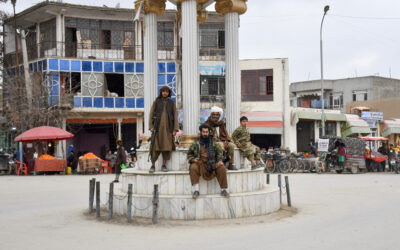
Blindsided by U.S. Ukraine Vote, Kremlin Scrambles to Respond
SUBSCRIBER+ EXCLUSIVE REPORTING — Russia’s reaction to the new infusion of U.S. aid for Ukraine has ranged from shrugs to fury, from warnings of nuclear […] More
EXPERT PERSPECTIVE — On March 24, North Korea successfully launched an Intercontinental Ballistic Missile (ICBM) called the Hwasong-17. The missile flew for 68 minutes and traveled up to a maximum altitude of 3,900 miles and a distance of 680 miles, making it capable of reaching the whole of the United States.
The Hwasong-17 is considerably larger than the two ICBMs launched in 2017 – the Hwasong 14 and 15 – and is likely capable of delivering multiple warheads. That’s concerning. North Korean leader Kim Jong-un was quoted by the Korean Central News Agency (KCNA), saying North Korea is “fully ready for long-standing confrontation with the U.S. imperialists.”
This was the twelfth ballistic missile launched in 2022. Launches over the last six months, have included two hypersonic ballistic missiles, a train-mounted ballistic missile, an intermediate range ballistic missile, submarine-launched ballistic missile, long-range cruise missiles and ballistic missile launches that tested systems related to military reconnaissance satellites. North Korea did not issue airspace or maritime safety notifications for any of these launches, representing a serious risk to international civil aviation.
North Korea’s nuclear programs also appear to be very active. On March 7, the Director-General of the International Atomic Energy Agency (IAEA) reported that there were “ongoing indications consistent with the operation of the 5-megawatt reactor at the Yongbyon site.” The IAEA also said they continued to observe construction activities at the Yongbyon site, including the construction of an annex to the reported Centrifuge Enrichment Facility, while commercial satellite imagery analysis indicated that there was renewed activity at the Punggye-ri nuclear test site, the first time since its closure in 2018.
April 15 will mark the 110th anniversary of the birth of Kim Jong-un’s grandfather, Kim il-sung. It’s likely Kim will memorialize the event with the launch of a military reconnaissance satellite, something Kim attempted to do in 2012, but was unsuccessful. We should also expect continued ballistic missile launches and a seventh nuclear test.
Ever since the failed Hanoi Summit in February 2019, between former President Donald Trump and Kim, negotiations with North Korea have ceased. And during these three years, North Korea has been upgrading its ballistic missile capabilities while continuing to produce fissile material for additional nuclear weapons. All this, despite the lock down in the North due to the COVID pandemic.
The Cipher Brief hosts expert-level briefings on national security issues for Subscriber+Members that help provide context around today’s national security issues and what they mean for business. Upgrade your status to Subscriber+ today.
China is North Korea’s only ally and its economic lifeline. The Sino-North Korean Mutual Aid and Cooperation Friendship Treaty of July 1961 was recently renewed for another 20 years by Chinese President Xi Jinping and Kim. China now provides over 90% of the crude oil and petroleum products the North needs, and over 90% of the North’s trade is with China. It is apparent that China has significant leverage with North Korea.
In 2003, when North Korea started to reprocess spent fuel rods at its nuclear facility in Yongbyon, for the plutonium needed for nuclear weapons, former Secretary of State Colin Powell reached out to his Chinese counterpart, Foreign Minister Li Zhaoxing, and asked that China intercede with the North, which China did. This was the beginning of the Six Party Talks that China hosted in Beijing, with China’s current Foreign Minister and State Counselor, Wang Yi, hosting the talks. Despite a September 19, 2005, Joint Statement signed by all six countries, that committed North Korea to dismantle all nuclear weapons and facilities, in return for security assurances, economic development assistance and a path to normal relations, the implementation of the Joint Statement ended in 2009, when North Korea refused to permit nuclear monitors to inspect undeclared suspect sites outside the Yongbyon complex.
It is time for China to again intercede with North Korea and, using its leverage, get the North to accept the unconditional invitation from the United States to meet anytime, anywhere. Once at the table, the United States and North Korea can resume a twenty-seven-year dialogue, with some hope that North Korea will realize that a path to normal relations with the United States, in return for complete and verifiable denuclearization and appreciable progress on human rights issues in the North, is in Kim Jong-un’s interest. The initial goal should be to get North Korea to agree to a moratorium on the production of fissile material for nuclear weapons and a moratorium on all ballistic missile launches and nuclear tests. A willingness to lift certain sanctions if North Korea accepts this initial proposal should appeal to Kim. This, then, would be the first phase in a long action-for-action negotiation process that will focus on the complete and verifiable dismantlement of all nuclear weapons and facilities in North Korea.
If North Korea refuses to re-engage, then the only principled option, working with our allies in South Korea and Japan, is to intensify a policy of containment and deterrence, with additional sanctions imposed on North Korea when they continue to violate United Nations resolutions prohibiting ballistic missile launches and nuclear tests. Also, the deployment of additional missile defense systems should be pursued, with an upgrade in joint military exercises.
Obviously, getting North Korea to return to negotiations with the United States and resuming inter-Korean talks with South Korea are our principled objectives with North Korea. Failure to accomplish these objectives will contribute to instability in the Indo-Pacific region.
This Opinion perspective from Cipher Brief Expert Ambassador Joe DeTrani was first published by The Washington Times
Read more expert-driven national security insights, perspective and analysis in The Cipher Brief because National Security is Everyone’s Business
Related Articles

SUBSCRIBER+ EXCLUSIVE REPORTING — Russia’s reaction to the new infusion of U.S. aid for Ukraine has ranged from shrugs to fury, from warnings of nuclear […] More

SUBSCRIBER+ EXCLUSIVE REPORTING — When Chinese President Xi Jinping came to San Francisco last November to meet with President Joe Biden, Chinese pro-democracy activists in […] More

SUBSCRIBER+EXCLUSIVE EXPERT PERSPECTIVE — More than two years after its withdrawal from Afghanistan, the U.S. still does not have a clear way forward in the […] More

SUBSCRIBER+ EXCLUSIVE REPORTING — Ukrainians greeted Saturday’s long-awaited House passage of $60.8 billion in aid with justifiable jubilation. For months, their soldiers, civilians, and political […] More

SUBSCRIBER+ EXCLUSIVE REPORTING — A race for control of space is underway, and just as on earth, the U.S. and China are the top competitors. […] More

SUBSCRIBER+ EXCLUSIVE REPORTING — For nearly a week, the Middle East and much of the world were on a knife’s edge, waiting for a promised […] More
Search